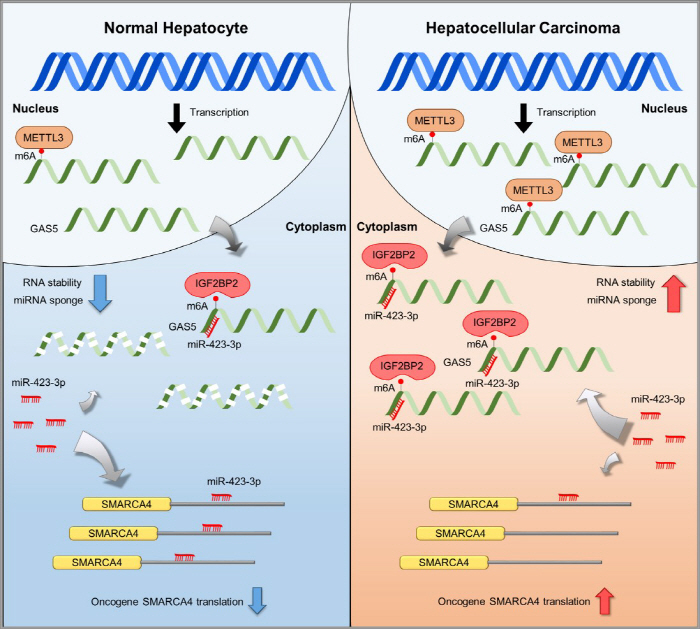Identifying the Gene Mechanism for Promoting Liver Cancer...Expecting a New Treatment Strategy
Jun 30, 2025
|
Professor Nam Seok-woo (corresponding author), research instructor Kim Sang-yeon (co-first author), and researcher Ha Jin-woong (co-first author) of the Catholic University School of Medicine's pathology class discovered that Growth Arrest Spectacular 5, well-known as a tumor suppressor gene, can play a role in promoting tumors in Hepatocellular Carcinoma (HCC). Among the RNAs that underwent a special chemical change (m6A modification) in RNA, GAS5, the only protein-producing RNA among the genes related to the 'IGF2BP protein' that regulates the lifespan of RNA, was found to be related to liver cancer.
GAS5 is known as a gene that stops cell growth in various carcinomas and prevents the spread of cancer cells. However, the research team noted that paradoxically, the expression of GAS5 is rather increased in tissues of hepatocellular carcinoma patients. To explain the paradoxical situation that there are many genes that need to suppress cancer, the research team has begun to analyze and experiment with big data.
To this end, the research team used big data from patients with liver disease, RNA analysis data from the World Genome Database (TCGA, ICGC, etc.), and various experimental models (including cell and animal experiments). The results demonstrated that GAS5 is not just a cancer suppressor gene, but a gene that promotes liver cancer under certain conditions.
The key point of this study is that the role change of GAS5 is due to 'epigenetic regulation'. Epigenetics refers to a phenomenon that regulates gene function without altering DNA itself. Among them, m6A modification is a mechanism that increases or lowers stability by giving RNA specific chemical modifications.
The research team also confirmed that when an m6A mutation occurs in GAS5, RNA does not decompose and survives for a long time, thereby increasing functional activity. This stabilized GAS5 indirectly regulates the expression of a gene called SMARCA4 while absorbing a small RNA called miR-423-3p. SMARCA4 is a gene that plays an important role in cell growth and gene regulation.
This process again leads to the regulation of sub-gene, forming a kind of genetic network that greatly affects the development of liver cancer. This linkage structure is called 'GAS5-miR-423-3p-SMARCA4 axis' and is attracting attention as a complex regulatory mechanism involved in the progression of cancer beyond simple gene interactions.
These findings go beyond mere academic contributions, and even present the possibility of application in practical treatment and diagnosis. The research team believes that a new liver cancer treatment strategy is possible by paying attention to enzymes that control the amount of GAS5, block the action of miR-423-3p, or regulate m6A modification.
In addition, GAS5, miR-423-3p, and SMARCA4 may be used as early diagnostic markers or prognostic predictors for liver cancer. In fact, hepatocellular carcinoma has few symptoms and is difficult to detect early, so many patients often start treatment late. This study is expected to contribute to the detection of liver cancer earlier and prediction of treatment response.
This result is of great academic significance in that it has a complex and dual function that makes it difficult to distinguish whether GAS5 is a cancer suppressor or a cancer promoter. This is an example of a single gene not only playing a fixed role, but also showing completely different appearances depending on the type of cancer, environment, and epigenetic conditions.
Professor Nam Seok-woo said, "This study demonstrates that epigenetic regulation is closely related to cancer development. It suggests that GAS5 may be used as a new anticancer target to develop RNA treatments or develop into biomarkers, and plans to continue follow-up studies to find out whether this mechanism is similarly applicable to other carcinomas in the future."
The study was published in the June 2025 issue of the International Journal of Experimental & Molecular Medicine (Impact Factor = 12.9). "Is GAS5 a suppressor or an enabler?" The answer to this question is no longer simple. The study, which revealed the 'bilateral' of GAS5, provides a new puzzle piece of cancer treatment precision and paves a new path toward overcoming liver cancer.
|
This article was translated by Naver AI translator.















